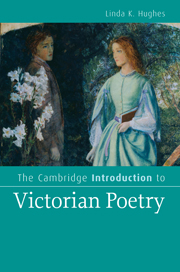Book contents
- Frontmatter
- Contents
- List of figures
- Preface
- Acknowledgments
- Editions cited
- Introducing Victorian poetry
- Part I The forms of Victorian poetry
- Part II The rhetoric of Victorian poetry
- Part III Coda Close readings
- 10 Elizabeth Barrett Browning, Aurora Leigh
- 11 Ernest Dowson, “Vitae summa brevis spem nos vetat incohare longam” and Thomas Hardy, “Friends Beyond”
- Glossary
- Notes
- Further reading
- Index
- Cambridge Introductions to Literature
11 - Ernest Dowson, “Vitae summa brevis spem nos vetat incohare longam” and Thomas Hardy, “Friends Beyond”
Published online by Cambridge University Press: 05 June 2012
- Frontmatter
- Contents
- List of figures
- Preface
- Acknowledgments
- Editions cited
- Introducing Victorian poetry
- Part I The forms of Victorian poetry
- Part II The rhetoric of Victorian poetry
- Part III Coda Close readings
- 10 Elizabeth Barrett Browning, Aurora Leigh
- 11 Ernest Dowson, “Vitae summa brevis spem nos vetat incohare longam” and Thomas Hardy, “Friends Beyond”
- Glossary
- Notes
- Further reading
- Index
- Cambridge Introductions to Literature
Summary
Both “Vitae summa brevis spem nos vetat incohare longam” (1896) by Ernest Dowson and “Friends Beyond” (1898) by Thomas Hardy concern the transience of human life and desire. Yet their styles differ markedly, a result of the alternative poetic traditions out of which they worked. Dowson was a member of the Rhymers' Club, along with W. B. Yeats, Lionel Johnson, Arthur Symons, John Davidson, and Richard Le Gallienne. Yeats records the group's aesthetic criterion of “poetry that was, before all else, speech or song,” and their attempt “to write like the poets of the Greek Anthology, or like Catullus, or like the Jacobean Lyrists …” That is, the group aimed for compression, elegance, refinement, and lyricism rather than moral statement or social purpose. Their aesthetic touchstones are clear in “Vitae summa brevis,” given in its entirety below:
They are not long, the weeping and the laughter,
Love and desire and hate:
I think they have no portion in us after
We pass the gate.
They are not long, the days of wine and roses:
Out of a misty dream
Our path emerges for a while, then closes
Within a dream.
Dowson signified the importance of “Vitae summa brevis” by placing it prior to the dedication page of his 1896 Verses, so that this lyric formed the keynote for his first published collection.
- Type
- Chapter
- Information
- The Cambridge Introduction to Victorian Poetry , pp. 276 - 284Publisher: Cambridge University PressPrint publication year: 2010



